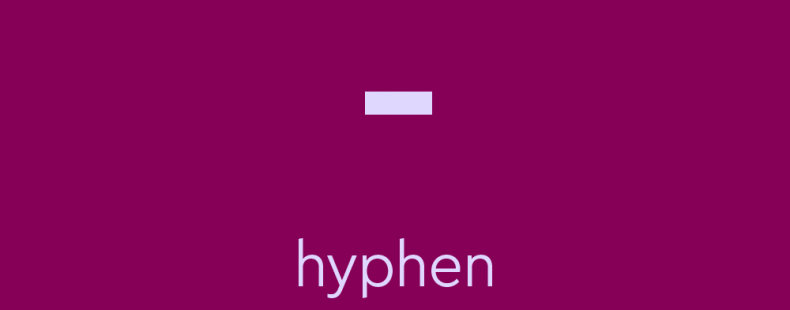In writing, we use a lot of compound words. Compound words include nouns like president-elect and sister-in-law, verbs like back-paddle and flash-freeze, and adjectives like best-case and top-of-the-line. All of these words rely on the same punctuation by using a hyphen to connect multiple words together. But not every compound word uses a hyphen. If you are curious about where and when we use hyphens, we have all the information you need to determine where you draw the line when it comes to hyphen usage.

What is a hyphen?
A hyphen is a punctuation mark that is often used to form compound words. A hyphen resembles a small horizontal line (-). Besides being used to form compound words, hyphens are also used to divide words on line breaks.
✏️ Examples of a hyphen in a sentence
The following sentences show how we commonly use hyphens to form compound words.
- The kids were playing with a jack-in-the-box.
- The team had two left-handed batters.
- She studied English literature from the pre-Elizabethan era.
- I have thirty-seven dollars in my wallet.
When do you use a hyphen?
In general, there are two common uses for a hyphen.
Compound words
Many compound words are formed using hyphens. Here are some examples:
- sold-out, slow-moving, happy-go-lucky, twenty-four, great-uncle
However, not all compound words use hyphens. For example,
- grandfather, classroom, beachfront, phone book, head coach, police officer
So, how do you know if a compound word uses a hyphen or not? Well, many compound nouns and verbs are listed in dictionaries—like ours! If you are unsure if a noun or verb uses a hyphen, you can look it up.
Compound adjectives are tougher. Often, you can form an adjective out of almost any pair of words you can think of, so many “temporary” compound words won’t appear in a dictionary. In general, there are two rules for using a compound adjective.
If the compound adjective comes before the noun, use a hyphen between the two words that form it:
- I love chocolate-covered pretzels.
- She is looking for fat-free snacks.
- It was a jazz-heavy lineup of music.
If the compound adjective comes after the noun, we typically don’t hyphenate it:
- The pretzels were chocolate covered.
- She is looking for snacks that are fat free.
- The musical lineup was jazz heavy.
Learn more about compound adjectives here.
In addition to these two, there are some other general rules that are typically followed regarding compound words.
When using prefixes, use a hyphen if the main word is capitalized, is a number, or is an abbreviation. For example,
- The story seemed to have an anti-French bias.
- We can never go back to the way things were in the pre-2000 world.
- The spy had pro-USSR allegiances.
If a prefix ends with the same letter as the main word, we may use a hyphen to make the word appear less awkward or confusing:
- anti-imperialist, co-own, pre-existing, semi-independent
Most (but not all) compound words that begin with self use a hyphen, regardless what part of speech they are. For example,
- self-esteem, self-pity, self-reflection, self-serving, self-centered
We use hyphens when writing out the numbers 21 through 99:
- twenty-five, forty-seven, sixty-one, eighty-eight
Dividing words on line breaks
In certain written works, such as newspapers or magazine articles, a hyphen is often used to divide a word across two lines for formatting reasons. Although the specifics vary depending on style guides, the general rules are typically as follows:
- A word is split after a complete syllable. For example, we would write cov-er rather than c-over.
- Look for ways to deconstruct the word naturally. For example, if a word uses prefixes or suffixes, you can use these to divide a word.
- If a word ends in -ing, a double consonant is split. For example, running would be written as run-ning.
- A word that already has a hyphen is simply split according to the hyphen.
- Depending on the style guide, other rules and exceptions will need to be followed.
Hyphens vs. dashes
The hyphen closely resembles the two types of dashes, the en dash (–) and the em dash (—). However, these three punctuation marks are not used interchangeably. He is a quick breakdown of how we generally use these three different marks:
- Hyphen: Compound words and line breaks.
- En dash: Ranges and more complex compound words, as in Please read pages 17–35 and She was a Pulitzer Prize–winning journalist.
- Em dash: Pauses and interrupted dialogue, as in The letter revealed that the culprit was someone I had never considered—me! or “I need you to—” was all he managed to say before falling overboard.
How to use a hyphen
As long as you can figure out if a word uses a hyphen or not, hyphens themselves don’t cause too many problems. However, there is one common mistake to watch out for.
-ly adverbs
It is possible to use adverbs in compound words that use hyphens, such as in high-flying or up-close. However, we typically do not use a hyphen if a compound word begins with an adverb formed by adding -ly to the end of an adjective or participle. This rule applies even if it comes before a noun. For example,
❌ Incorrect: It was a closely-guarded secret.
✅ Correct: It was a closely guarded secret.
❌ Incorrect: Everyone ran from the quickly-approaching tornado.
✅ Correct: Everyone ran from the quickly approaching tornado.
Ready to test your punctuation skills? Quiz yourself on hyphens, en dashes, and em dashes.
Connect with grammar! Try Grammar Coach™
Not sure if you’re using the hyphen, en dash, or em dash correctly? Check your writing on Thesaurus.com’s Grammar Coach™. This writing tool uses machine learning technology uniquely designed to catch grammar and spelling errors. Its Synonym Swap will find the best nouns, adjectives, and more to help say what you really mean, guiding you toward clearer, stronger, writing.














